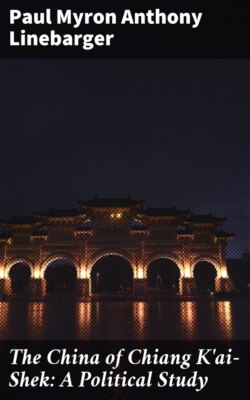Читать книгу The China of Chiang K'ai-Shek: A Political Study - Paul Myron Anthony Linebarger - Страница 28
На сайте Литреса книга снята с продажи.
Social and Cultural Agencies
ОглавлениеTable of Contents
The Ministry of Education (Chiao-yü Pu) has continued active despite the war. The heroic marches of the Chinese universities to their new homes in the West have become a world-famous epic. Students, faculty, and staffs moved out of the sinister zones of enemy occupation, usually travelling on foot, until they found new homes hundreds or even thousands of miles from their original locations. Some colleges have found homes in old temples or in caves where, with a minimum of equipment and library material, they continue their work. Others, more fortunate, have become guests of West China institutions. West China Union University in Chengtu has four other universities on its campus, all using the same facilities for the duration of the war. Still other institutions have been consolidated.
The Ministry of Education has subsidized education as generously as possible, and fosters progress despite the war and because of it. In spite of all handicaps, institutions of higher learning have risen in number from 91 in 1937–38 to 102 in 1939–40, with a corresponding rise in enrollment of 31,188 to 41,494.[12] The entering class for 1940–41 was about 12,000, indicating a continued rise.[13]
In addition to the accredited institutions, there are innumerable volunteer agencies, some of which are patriotic but educationally elementary schools for saboteurs, agitators, and guerrillas. Education is propaganda, but such is its immediate appeal that Left schools obtain capacity attendance. A few students are disappointed. One wrote, "The most unpleasant thing to me was that, as soon as I entered the Resist-Japan University, I was deprived of my liberty. I was not free in speech; I was not allowed to say anything outside of Marxism-Leninism … " and went home.[14] The total attendance remains high; if added to that of the accredited institutions operating according to government standards, it would swell the sum enormously.
In addition to formal aid to institutions of higher learning, and administration of the National Government colleges, the Ministry sponsors the mass literacy movement. In this it has had the benefit of the work of Dr. James Y. C. Yen and his associates.[15] The war, moving vast masses of people and shifting the modernized city-dwellers from the coast to the interior, has proved a stimulus to the rise of literacy and the demand for popular literature.
The Ministry is headed by Ch'ên Li-fu, whose brother, Ch'ên Kuo-fu, is head of the (Kuomintang) Central Political Institute. Together they stand at the Right center of the Kuomintang, exerting enormous influence on the Party and on the country. Both have been very close to the Generalissimo, and took a large share in revitalization of the Kuomintang before and during the war.
The two Commissions serve important needs. The Commission on Overseas Chinese Affairs (Ch'iao-wu Wei-yüan-hui) is the informal Chinese equivalent of a colonial office. The Commission looks after the welfare of the overseas settlements of the Chinese, fostering language schools, hospitals and the like. It acts through Chinese community associations, rarely through official channels. Practices of hyphenated citizenship, so offensive to one Western nationality when undertaken by another, are unobtrusive and necessary in the case of the Chinese. With the outside states putting Chinese in a special economic, legal, and political category—through immigration laws, administrative practice, and extra-governmental pressure including lynching—the individual Chinese who deracinates himself is indeed a lost soul. Few Chinese worry about overseas Chinese irredentas. The Commission fosters no putsches and mobilizes no fifth columns, but does help to keep Chinese, whatever their nationalities, still Chinese.
The Commission on Mongolian and Tibetan Affairs (Mêng Tsang Wei-yüan-hui) is the supreme agency for the dependencies. It has a record of considerable success in fostering a good-neighbor policy toward the half-autonomous dominions of Chinese Turkestan (Sinkiang, also called Chinese Central Asia),[16] Tibet, and Inner Mongolia. Outer Mongolia is under indirect Soviet control, and Eastern Inner Mongolia under the Japanese. The Chinese have utilized every device of courtesy and diplomacy in retaining their precarious grip on these areas. The Commission includes dominion members.
